The use of snipers in battle, according to the experience of the Great Patriotic War
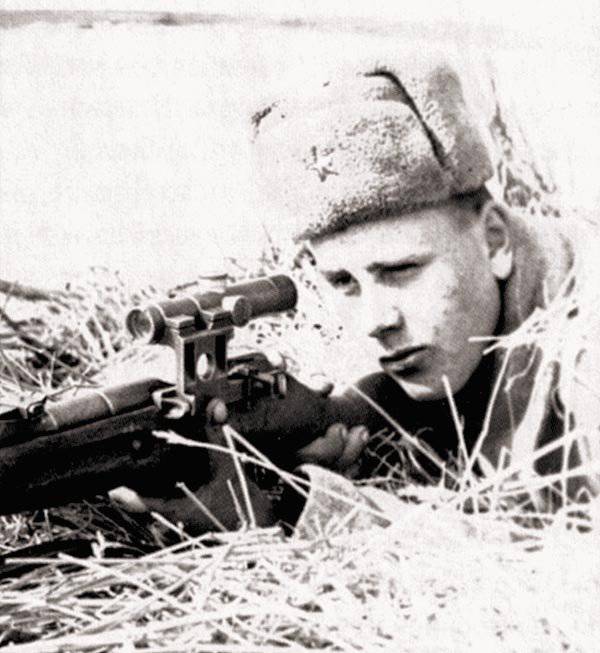
Statistics knows everything, everything and everyone. The same is true with sniping. According to accurate statistics, during the Second World War, the allies had to spend up to 25000 ammunition on each German destroyed, while a trained sniper needed the entire 1,3 bullet for this purpose.
Back in the years of the First World War, the increased effectiveness of artillery fire and the widespread use of automatic weapons entailed the large-scale use of virtually all armies of belligerent countries to protect personnel of various kinds of shelters, field fortifications, etc. This necessitated the identification of particularly well-aimed shooters - snipers who, observing the battlefield and the fortified lines of the enemy, could destroy individual soldiers and officers of the enemy, preventing them from observing and moving. However, the camouflage in the armies of the adversaries over time improved more and more, so it took the ability and ability of the shooter to observe the battlefield and measure distances to targets. Due to the fact that it became more and more difficult to find masking targets on the battlefield with the naked eye, well-aimed shooters needed special means of observation. With snipers began to conduct additional training in shooting, equip them with observation devices, camouflage suits. Small targets and their remoteness required the creation of special weapons for snipers, adapted for aptly fired. And such a weapon was created. However, not only the special weapon determined the sniper's success, but also the ability to shoot accurately, which, in turn, was determined by three basic conditions: the ability to correctly aim and shoot; appropriate physical and psychological training, as well as the arrow instinct.
During the Great Patriotic War, the decisive superiority of Soviet snipers over the enemy was revealed. Immediately after the end of the war, the Main Directorate of Combat Training (GUBP) of the land forces of the Red Army, relying on considerable combat experience, began to fundamentally improve the issues of infantry training, including snipers. At one of the meetings, the experience gained by the snipers during the war years was analyzed in detail and a number of new proposals were put forward to improve their training.
The experience of the Great Patriotic War showed that targets on the field of modern combat are usually masked, covered in various fortifications and appear only for a very short time. This especially applies to such goals as officers, observers, snipers, machine gunners, who are able to have a decisive influence on the success of the attack. That is why they should be hit immediately.
The listed targets could not always be revealed by ordinary shooters and machine gunners. This required a special-purpose fighter - a reconnaissance observer, equipped with an appropriate observation device and able to find the most important of the mass of targets. Since the targets appeared for a very short time, then, naturally, they could not be assigned to defeat ordinary shooters. Consequently, the observer-intelligence officer himself should have been able to hit the target instantly, at the moment of its appearance. The sniper became such a fighter in which the scout-observer and the fighter-gunner combined.
TASKS OF SNIPERS IN FIGHT
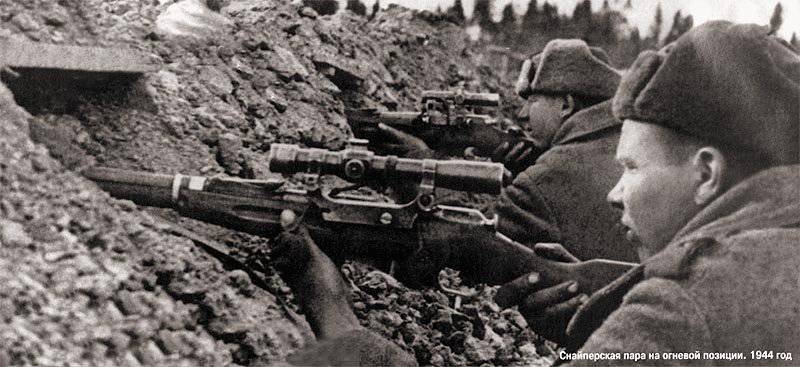
The task was usually set by snipers immediate superior. But sometimes, if the situation required, snipers received instructions from the company commander, battalion and even the regiment. Firing positions snipers chose at their discretion, using the terrain and local objects.
At the front, the following combat missions were usually set for Soviet snipers. In an offensive battle: destroy officers, liaisons, snipers, fighters tanks and enemy observers, calculations of guns and anti-tank rifles, and with the development of success in the depths of the enemy defense and the pursuit of the enemy, calculations of machine guns, especially flanking and dagger actions, officers, snipers, direct-fire gunners, observers and spotters of artillery fire; conduct fire on the embrasures of bunkers, bunkers, armored caps, periscopes and stereo tubes; Observe the enemy and indicate (with tracer bullets) targets to other weapons. In a defensive battle: destroy officers, liaison officers, snipers, faustpatrons, reconnaissance and observers of the enemy, calculations of his machine guns, guns, anti-tank rifles, crews of damaged or set fire to tanks; firing at low flying aircraft, viewing gaps of tanks, armored vehicles, armored personnel carriers; on behalf of the commanders to observe the enemy. In addition, offensive and defensive snipers were given limited tactical tasks to ensure flanks and joints from counterattacks and from enemy seepage.
Basically, these tasks are consistent with the provisions of the Infantry Battle Regulations. However, combat practice has shown that either some of the tasks listed above are beyond the reach of snipers, or their setting is impractical. For example, only massive fire, and not an individual sniper shot, is effective against tank slots and enemy downgrades; reliable cover of the flanks could be ensured by the release of sufficiently strong guards with anti-tank weapons, and not just snipers; target designation with tracer bullets unmasked the sniper's position and prevented him from remaining on it to perform the further task. According to the experience of the war, it was revealed that target designation with tracer bullets from a sniper rifle is inexpedient, since the trail of these bullets is hardly noticeable and does not attract the attention of those who receive target designation.
The preference for target designation was given to a series of bullets (the queue) from the machine gun (manual) machine gun. The use of snipers as observers was allowed only in exceptional cases, because ultimately the sniper is first and foremost a fighter, solving a combat mission by fire.
GOALS AND DISTANCES
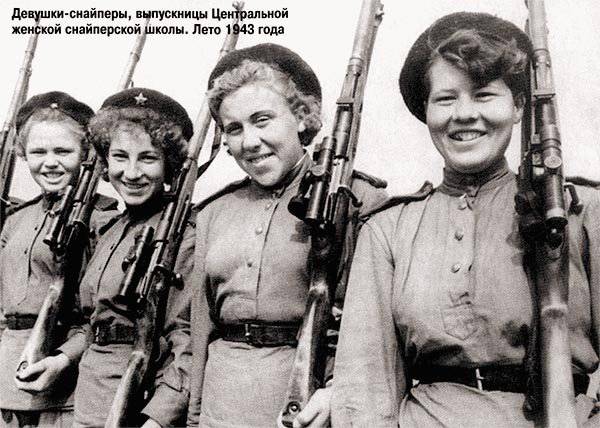
The main targets for snipers were: in offensive combat - the upper part of the head (15 × 20 cm), head (25 × 20 cm), the head figure (25 × 30 cm), the observer (20 × X25), stereo tube (15-18 × 8 × 20 × 8 cm) , periscope (20 × 25 cm), embrasures of various types (80 × 50-60 cm), traversing the message of a figure (80-50-40 × 60 cm), positioning machine (50 X80cm), draw stitch (160 XXXXXXX) 70 cm), positioning machine (25 XXXXUMXcm), draw stitch (20-25 × 30 cm), positioning machine (20 XXXXXXXX) XYNUMX cm), positioning machine (25 XXXXNXX cm), draw stitch (50-50 × 50 cm); (60 × 60 cm), tool trench (80 × 50 cm); in defensive combat head (150 × XNUMX cm), head figure (XNUMX × XNUMX cm), observer (XNUMX × XNUMX cm), chest figure (XNUMX × XNUMX cm), light machine gun (XNUMX × XNUMX cm), easel machine gun ( XNUMX × XNUMX cm), running figures (XNUMX × XNUMX cm), crawling figures.
Targets for snipers in an offensive battle, as a rule, were hidden in the trenches and other engineering structures and carefully masked. The moving targets appeared for short periods of time (4-6 seconds) at a speed of movement 2-3 m per second. The main firing distances in the offensive (in the event of a defense breakthrough) are limited by the distance of their troops to the line of the firing shaft or the distance between the two main trenches (that is, they do not exceed 400 m). When fighting in depth or when approaching on the move, as well as during pursuit, the distance increased to 600 m. Most of the smaller targets were within 250-300 m.
In a defensive battle, the goals that the snipers had to hit were larger, mostly open and moving. The smoke of target areas with exploding shells and mines and dust from them made it difficult to observe and fire. In positional defense during the lull of battle, the nature of the targets remained the same as in offensive combat. Shooting distances are up to 800 m. Consequently, the sniper’s maximum shooting distance is 800 m. However, most often the sniper fired aimed fire at a distance of up to 600 m.
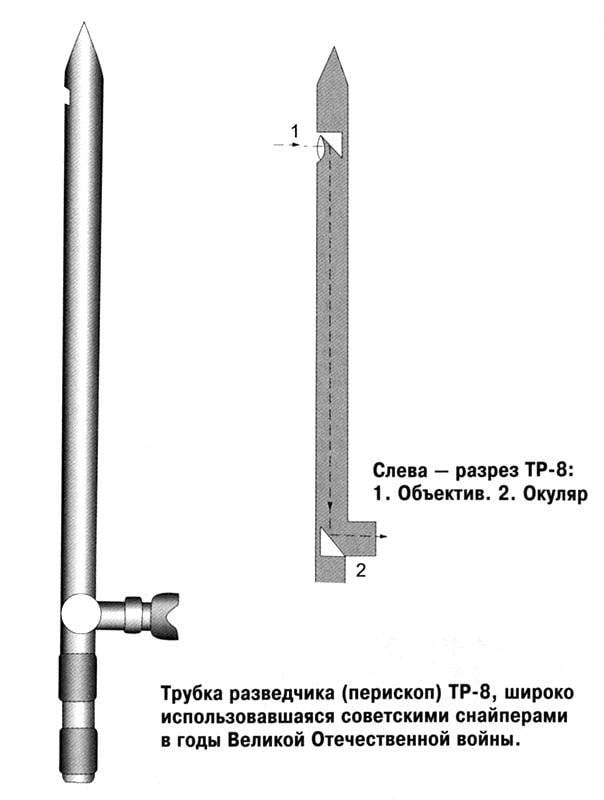
In offensive combat, as in defense, it was also recommended to use snipers in pairs in the best way: one fires, the other observes. To do this, they had to be located at such a distance from each other in order to be able to maintain communication with each other, not only visual, but also voice.
Thus, in one of the battles, the advance of our rifle subunits was strongly inhibited by the well-camouflaged flanking enemy machine guns, which fired alternately. The commander of the attacking guards ordered the snipers to be sent to his right flank with the task of suppressing the enemy firing points.
The snipers of the guard foreman Budenkov and the guard sergeant Khandogin crawled forward to the right of their unit and, sitting in 50 meters from each other, began to observe. Soon one of the enemy’s machine gunners opened fire. Budenkov noticed him - the Germans shot from the ruins of the building. The foreman approximately determined the distance, set the scope, corrected the side wind, and with the first shot put the gunner out of action. A few minutes later destroyed another machine-gunner and sniper Handogin.
As the unit progressed, both snipers, remaining on the flank, consistently changed firing positions, firing at officers, machine gunners and other important targets. The following data eloquently testifies to the effectiveness of their fire: in a few days of fighting, Budenkov and Khandogin crushed 12 German machine guns and destroyed more 50 Nazis.
Single snipers and sniper groups consisting of 3-5 and sometimes all sniper units were also widely used in offensive combat. Thus, in one of the regiments, a large sniper group supported the actions of the reconnaissance party. Concentrated fire snipers incapacitated enemy firing points that prevented the scouts from carrying out their combat missions.
The commander of the other unit successfully used a group of snipers to repel the flank counterattack of the Germans. He sent out machine-gunners and 5 snipers from his reserve to counter-attackers. While the machine gunners were moving closer to the enemy, snipers fired several officers and non-commissioned officers out of place with precise fire. The Germans stopped in confusion. At this time, our submachine gunners opened fire, having managed to get close to the distance of the real fire of their weapon. The enemy, having suffered losses, retreated.
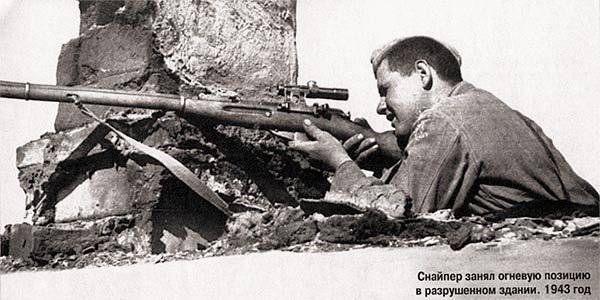
The fact of the Soviet "sniper offensive" is also known. On one of the sections of the front several dozen snipers with continuous precise fire forced the enemy to leave two lines of trenches. It is possible to give such a typical example of the actions of single snipers in battles for populated areas.
Our rifle division knocked the enemy out of the corner building, from where they looked through the square and two streets (one of which led to the bridge over the river). The unit commander ordered the machine gunner commander, Sergeant Vatagin, to take a position in the attic and close the enemy’s retreat to the opposite bank with fire. Together with the machine gunners in the attic was left White sniper.
Vatagin masterfully performed his task. In a short time, he shot several dozen Nazis. However, the position of the machine gun was discovered. From the opposite house, the Germans opened fire with a large-caliber machine gun. The second number of calculation Boychenko was seriously injured.
Sniper White with a well-aimed shot from the dormer window shot down an enemy machine gunner. The Germans dragged the machine gun into another apartment and began to install it by the door overlooking the balcony. The sniper beat the enemy: in a few shots he destroyed the enemy's machine gunners. In the next half hour, Belykh killed several more enemy soldiers and one officer who were trying to disable our firing point. Then the Germans rolled an anti-tank cannon into the square and made three shots at the attic. Both our machine-gunners were wounded by shell fragments, and Boychenko a second time. Again rescued sniper. He opened fire through a hole in the roof, killed the gunner of the gun and the soldier who replaced him. The surviving German artillerymen rushed to hide.
Soon some of our machine gunners approached the sniper’s help. The enemy did not manage to break through the bridge.
As can be seen from the above examples, single snipers, sniper couples and groups acted in combat, both independently and in cooperation with rifle divisions, reconnaissance parties, machine gunners, and individual machine guns. Often, snipers interacted with direct-impact guns, as well as mortar guns. The interaction most often boiled down to ensuring the advancement of the rifle division (reconnaissance party) or to ensuring the normal operation of the firing point, the vitality of which is especially important for the attacking side. In turn, rifle subunits and mortars covered the positions of snipers with fire in order to exclude the possibility of their bypass and capture by the enemy.
SELECTION AND EQUIPMENT OF FIRE POSITION
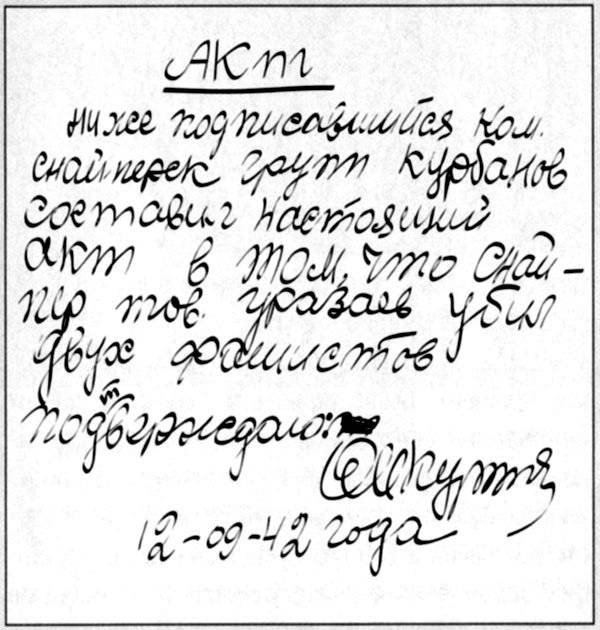
Successful execution of a combat task by a sniper largely depended on their ability to select a firing position, equip it and disguise it. The experience of the war showed that most of the Red Army snipers made it much more skillful than the enemy. But it was constantly stressed that the place for shooting should have been chosen in such a way that it made it possible to view the front edge of the enemy’s defense well; had a natural masking background (grass, weeds, bushes, etc.) that could hide the sniper's actions from observation of the enemy; if there is no such masking background, then the firing position is best chosen on the ground without landmarks with uniform relief that does not attract the attention of the enemy; had by their troops hidden approaches or conditions to create them.
In a stable front, when the distance to the enemy did not exceed 400 m, the sniper could equip a firing position in the first trench; if the distance to the enemy exceeded 400 m, then firing positions should be carried out in the neutral zone. In the latter case, under the firing positions could be used funnels, old trenches and trenches, as well as local objects that do not attract the attention of the enemy. If the situation permitted, the firing positions of the snipers could be equipped behind the first trench - in the bush, on the hill, in the thickets of trees, etc.
Before the onset of the offensive, snipers had to equip firing positions only in the initial trench (at the attack line), and later - in the depth of the enemy’s defense, use captured trenches, building ruins, attics, wrecked tanks and vehicles, breaks in the walls, stone placers (in wooded - rocky terrain). In the forest, firing positions are best chosen in the depths of the clearing, where the sound of the shot is softened. With the same purpose, in an open area, positions should have been chosen so as to have a hollow ahead. To perform a combat mission in defense, it was necessary to equip 3-4 firing positions, including one main and two - three spare ones.
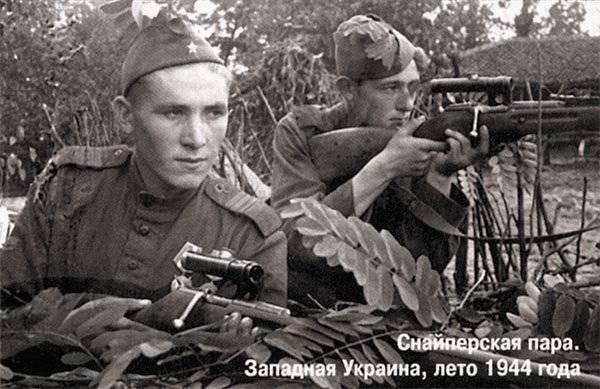
In addition, in the presence of time, it was advisable for snipers to have one or two false positions. Sniper should occupy the firing positions before dawn, and in the presence of hidden approaches - at any time. The equipment and their occupation usually happened as follows: on the first day the sniper conducted a study of the battlefield and outlined the position, and with the onset of darkness equipped it and masked it; on the second day, he critically checked the quality of the equipment and the camouflage of the firing position and occupied it at night, before dawn; on the third day he performed a combat mission.
Experience has shown that the enemy can detect the position of a sniper after 3-4 shots. Based on this, it was constantly emphasized that it is advisable for snipers to change their position after 3-4 shots.
During offensive battles, the most effective was the fire from distances to 400 m, since under the conditions of the offensive, snipers did not have enough time to prepare accurate data for shooting. The distance to the target was determined using an optical sight or improvised means. Often, snipers used the eye method - by laying off in depth the terrain sections according to 100-200 m, as well as by the degree of visibility of the target. The latter method was the simplest and at the same time fairly accurate.
The experience of numerous battles has shown that the enemy made extensive use of his snipers both in front of our offensive forces and in their rear. In both cases, the Nazis pursued one goal - to upset the control, to ease the onslaught, to inflict on us the greatest possible damage in manpower, especially in the officer corps. To fight the enemy snipers snipers usually spilled. When detecting the position of one enemy sniper, our snipers tried to find his partner (they, as a rule, are located apart from each other in 50-100) and neutralize both of them at the same time. In the course of the battle in the settlements, the sniper should have, in addition to the usual supply of cartridges, of which 30-40 accounted for percent of the cartridges with armor-piercing incendiary bullets, also several hand grenades.
ORGANIZATIONAL MATTERS
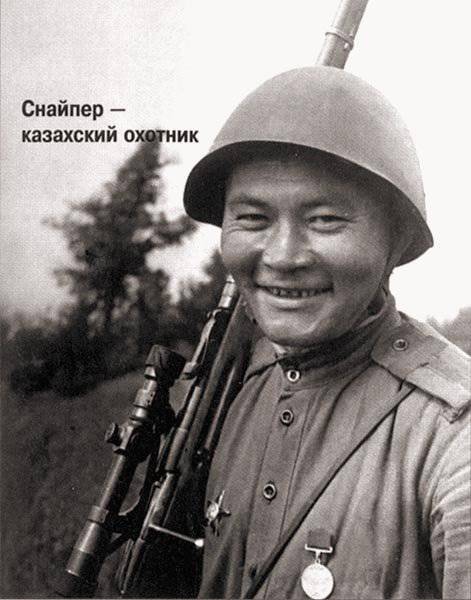
At the same time, it was emphasized that the existing organization and procedure for using snipers in the Red Army had not fully justified itself in the war. For example, a sniper pair, operating in a platoon order of battle, is extremely constrained in choosing firing positions by a narrow offensive front and a small defense area. In addition, without receiving specific tasks, snipers very often had to perform the functions of ordinary shooters or, at best, act as liaisons and observers. Therefore, along with the authorized use of snipers, consolidated teams and groups of various numbers have become widespread. Such teams were created mainly in periods of calm - in defense - with connections, units and subunits.
However, experience has shown that the creation of consolidated sniper teams also did not always produce the desired results. Therefore, a proposal was made that the most acceptable organization is a permanent sniper group in a rifle company. This group should have included a commander (he is an instructor) and 8 snipers. The company commander, organizing the system of fire of his company, in this case could use the snipers most appropriately in the group, personally setting it a task or giving individual sniper pairs to the platoons. The width of the front and the depth of the combat order of the company in the offensive and in the defense are sufficient for snipers to successfully use the terrain to select firing positions. It was assumed that the combat activity of the group would be conducted under the direct supervision and constant control of its commander.
The experience of the war showed that, regardless of the organizational structure, the main fire unit is a sniper pair (sniper fighter and sniper observer). Of course, in some cases, snipers could act alone, for example, in conditions of stable defense, when the parties are in direct contact and the sniper does not need to choose a firing position in the neutral zone.
The use of snipers in pairs allowed for a long and continuous observation; find targets faster; Do not fear for the fate of one of the partners, as the sniper-observer can promptly warn the sniper fighter of the danger threatening him or he will destroy the enemy that appeared suddenly; better to observe the results of the fire; it is better to prepare the firing position; widely use various methods of deceiving the enemy; give each other moral support; practically teach a young, novice sniper on the experience of a partner.
To solve a specific problem, snipers can be reduced to groups of several pairs. The group use of snipers is justified in cases where it is necessary to quickly recapture the fire initiative from the enemy in one or another sector of the leading edge or retain the critical sector where the use of heavy infantry fire weapons is difficult or completely impossible. Sniper groups have also been very successful in ambushes and in repelling enemy counterattacks aimed at a certain section of the battle formation.
In all cases, without exception, snipers within the group must act in pairs. Group - the concept of a collective, quantitative.
As a result of the foregoing, it was concluded that in modern combat, along with the massive fire of automatic weapons, an exact individual sniper shot is also needed. In this case, the actions of snipers can be successful only if they have high combat skills. The sniper is not only a skilled shooter and a great observer; he must be able to navigate in the situation and on the ground, choose from an abundance of diverse goals the most important. And it is first of all necessary to consider this when training snipers.
In conclusion, it was proposed that the permanent organizational unit of the snipers in the company should be a squad of 8 people (plus the squad commander), and the firing unit should be a sniper pair. In the process of special training of snipers, serious attention should be paid to the development of combat endurance, the development of visual, auditory and other perceptions, the cultivation of dexterity and courage.
Information